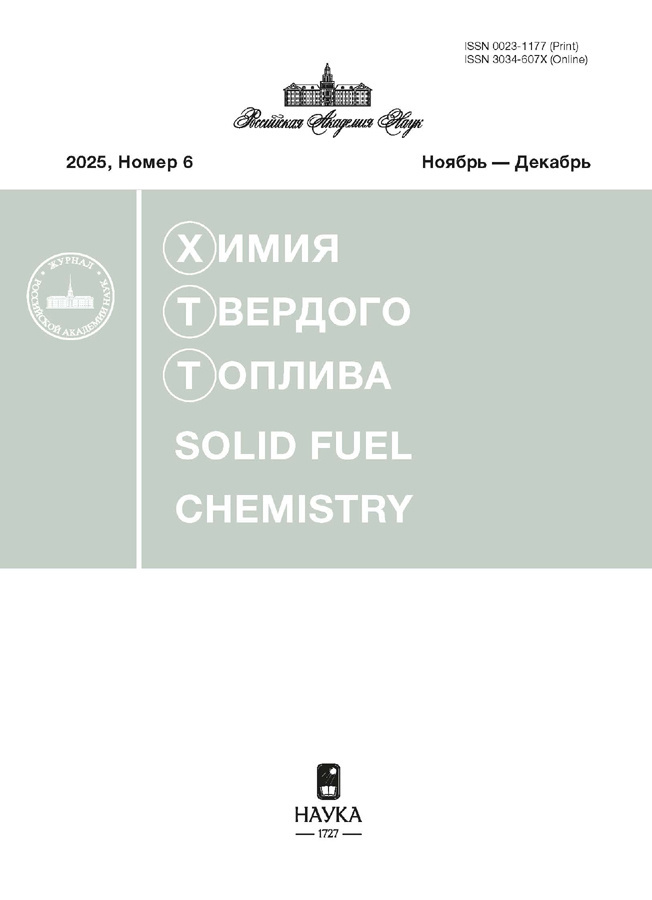Activation of the process of layer combustion of bitter coal with iron nitrate and waste of metal rolling production
- Authors: Shuataev M.K.1, Kaltaev A.Z.1, Larionov K.B.1,2
-
Affiliations:
- National Research Tomsk Polytechnic University
- Gorbachev Kuzbass State Technical University
- Issue: No 3 (2024)
- Pages: 59-66
- Section: Articles
- URL: https://gynecology.orscience.ru/0023-1177/article/view/677495
- DOI: https://doi.org/10.31857/S0023117724030085
- EDN: https://elibrary.ru/NBVCOR
- ID: 677495
Cite item
Abstract
The influence of metal-rolling production waste and iron nitrate on the characteristics of the process of layer combustion of coal is investigated. As a solid fuel, coal of the T grade was used. Metal scale and iron nitrate were introduced into the fuel by mechanical mixing. According to XRD data, phases of iron oxides Fe3O4 and manganese Mn3O4 were identified in the metal scale. The characteristics of the combustion process of the studied samples were studied using high-speed video with the use of a combustion chamber at a heating medium temperature of 700°C. Combustion Also, the process of activated layer combustion coal was scaled using a solid fuel boiler unit. It has been experimentally established that the use of metal scale and iron nitrate leads to an increase in the reactivity of the fuel, as evidenced by a decrease in the ignition delay time. Due to the intensification of the combustion process, the fuel underburning and the concentration of CO formed in the composition of gas-phase combustion products were reduced.
Full Text
About the authors
M. K. Shuataev
National Research Tomsk Polytechnic University
Author for correspondence.
Email: mks11@tpu.ru
Russian Federation, Tomsk, 634050
A. Zh. Kaltaev
National Research Tomsk Polytechnic University
Email: azk2@tpu.ru
Russian Federation, Tomsk, 634050
K. B. Larionov
National Research Tomsk Polytechnic University; Gorbachev Kuzbass State Technical University
Email: laryk070@gmail.com
Russian Federation, Tomsk, 634050; Kemerovo, 650000
References
- URL: https://www.iea.org/energy-system/fossil-fuels/coal (Дата обращения 09.10.2023).
- URL: https://www.iea.org/data-and-statistics/data-tools/greenhouse-gas-emissions-from-energy-data-explorer (Дата обращения 09.10.2023).
- Ismagilov Z.R., Kerzhentsev M.A. // Catal. Today. 1999. V. 47. № 1–4. P. 339.
- Simonov A.D., Fedorov N.A., Dubinin Y.V., Yazykov N.A., et al.// Catal. Ind. 2013. V. 5. № 1. P. 42.
- Xuzhong G., Guo Zh., Wang Zh.// Combustion and Flame 2010. V.157. № 2. P. 351.
- Ma B.G., Li X.G., Xu L., Wang K., Wang X.G. // Thermochimica Acta. 2006. V. 445. №. 1. P. 19.
- Yin K., Zhou Y.M., Yao Q.Z., Fang C., Zhang Z.W. // Reaction Kinetics, Mechanisms and Catalysis. 2012. V. 106. №. 2. P. 369.
- Zou C., Wen L., Zhang S., Bai C., Yin G. // Fuel Process Technol. 2014. V. 119. P. 136.
- Cheng J., Zhou F., Xuan X., Liu J., et al. // Fuel. 2017. V. 187. P. 398.
- Zhang H., Dou B., Li J., Zhao L., Wu K. // J. Energy Inst. 2020. V. 93. P. 2526.
- Lei Z., Liu M., Yan J., Chun T. et al. // Fuel. 2021. V. 289. P. 119779.
- Zou C., Zhao J. // J. Energy Inst. 2017. V. 90. P. 797.
- Larionov K.B., Berezikov N.., Kaltaev A.Zh. Gorshkov A.S. // Coke Chem. 2022. V. 65. P. 167.
- Larionov K.B., Mishakov I.V., Slyusarskiy K.V., Tsibulskiy S.A., Tabakaev R.B., Bauman Y.I., Vedyagin A.A., Nalivaiko A.Y., Gromov A.A. et al. // Fuel Process. Technol. 2021. V. 213. P. 106706.
- Wang C., Lei M., Yan W., Wang S., Jia L. // Energy and fuels. 2011. V. 25. № 10. P. 4333.
- Gubin A.V., Kaltaev A.Z., Gorshkov A.S., Matveeva A.A., Larionov K.B. // Coke Chem. 2023. V. 66. № 5. P. 237.
- Larionov K.B., Kaltaev A.Z., Berezikov N.I. et al. // Combust. Sci. Technol. 2022. P. 1.
- Carvill J. Mechanical engineer’s data handbook. Butterworth-Heinemann, 1994. 342 p.
- Kuznetsov G.V., Malyshev D.Y., Syrodoy S.V. et al. // Combust. Sci. Technol. 2022. V. 194. P. 1003.
- Wiwik S Watanabe, Dong-Ke Zhang. // Fuel Process. Technol. 2001. V. 74. P. 145
- Wang Y., Wang J., Chen H., Yao M., Li Y. // Chem. Eng. Sci. 2015. V. 135. P. 294.
- Richardson H.W. Copper Compounds in Ullmann’s Encyclopedia of Industrial Chemistry 2002. 30 p.
- Yanguang Ch., Guo Zh., Wang Zhi. // Fuel Proc. Technol. 2009. V. 90. № 7–8. P. 933.
- Larionov K.B., Gromov A.A.// Intern. J. Coal Science & Technology. 2019. V. 6. № 1. P. 37.
- Sun J., Zhao B., Su Y. // Energy. 2019. V. 185. P. 229.
- Müller C.R., Bohn C.D., Song Q.,. Scott S.A, and Dennis J.S. // Chem. Engng J. 2011. V. 166. № 3. P. 1052.
- Yang N., Yu J., Dou J., Tahmasebi A. et al. // Fuel Process. Technol. 2016. V. 152. P. 102.
- Fennell P.S., Dennis J.S., Hayhurst A.N. // Energy & Fuels. 2011. V. 25. № 4. P. 1510.
Supplementary files












